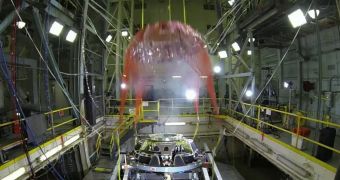Officials with the American space agency announce the successful completion on January 16 of a critical parachute deployment test for the Orion Multi-Purpose Crew Vehicle (MPCV). The tests were conducted in Arizona, at the US Army's Yuma Proving Grounds.
The main article tested was a piece of hardware that goes on top of the next-generation capsule. This component plays a very important role in protecting Orion during its ascension to orbit, during its flight through space, and as it reenters its atmosphere. However, it needs to be jettisoned high in Earth's atmosphere, shortly after reentry heat dissipates.
The hardware covers up the spacecraft's massive parachute system, which cannot deploy until the way is clear. The recent tests were conducted in order for NASA engineers to gain a deeper understanding of the performances the jettison system displays. It will be absolutely critical for future manned missions that this system works flawlessly.
Before the capsule jettisoned its forward bay cover (FBC), NASA engineers attached a large number of sensors to the spacecraft, and also centralized important amounts of telemetry data on the behavior of the capsule. Orion program manage Mark Geyer says the tests were very complex to carry out.
“This was a tough one. We'd done our homework, of course, but there were elements here that could only be tested in the air, with the entire system working together. It's one of the most complicated tests that we'll do, so we were all excited to see it work just as it was meant to,” the official said before the flight.
Unlike other tests conducted at Yuma, where the Orion parachute system was tested without the FBC, an extra layer of complexity was added for this assessment. The FBC itself was outfitted with three parachutes, whose role was to take it far away from the descending Orion, and to land it safely.
“The parachute deployment and forward bay cover jettisons are two of the most difficult things for us to model on computers. That's why we test them so extensively,” explained Chris Johnson, the manager of the parachute development and integration efforts for MPCV.
“These systems have to work for Orion to make it safely to the ground, and every bit of data we can gather in tests like these helps us improve our models and gives us more confidence that when we do it for real, we can count on them,” Johnson went on to say.
The jettison system was first tested in late December 2013 by engineers at Lockheed Martin, which is the primary contractor for the entire Orion spacecraft. The thruster system used to take the FBC off the capsule was built by Bothell, Washington-based Systima Technologies Inc.
Orion is scheduled to take its maiden flight, designated Exploration Flight Test-1 or EFT-1, in September 2014. An unmanned version of the capsule will launch to space from the Cape Canaveral Air Force Station, aboard a United Launch Alliance Delta IV Heavy delivery system.

 14 DAY TRIAL //
14 DAY TRIAL //